Non-fatal injuries 70+ Total number of deaths 0 | Date May 8, 1970, 8:55 AM PDT | |
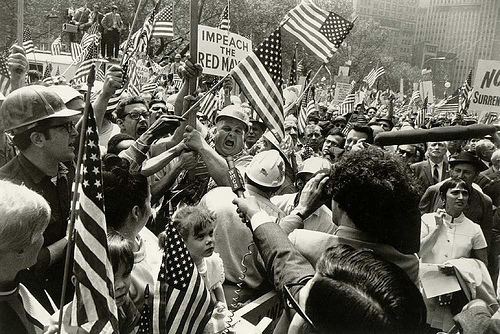 | ||
Perpetrators NYC union trade/construction workers | ||
Hard hat riots
The Hard Hat Riot occurred on May 8, 1970 in New York City. It started around noon when about 200 construction workers mobilized by the New York State AFL-CIO attacked some 1,000 college and high school students and others who were protesting the May 4th Kent State shootings, the Vietnam War, and the April 30th announcement by President Richard Nixon of the U.S. invasion of Cambodia. The Hard Hat Riot, breaking out first near the intersection of Wall Street and Broad Street in Lower Manhattan, soon spilled into New York City Hall, and lasted approximately two hours. More than 70 people, including four policemen, were injured on what became known as "Bloody Friday". Six people were arrested.
Contents
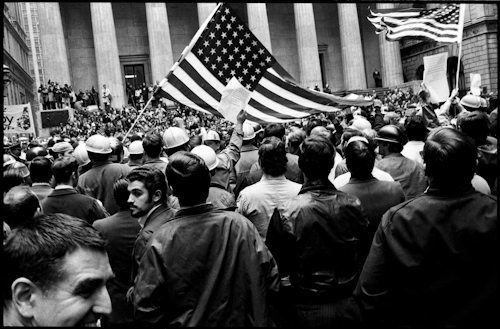
Background
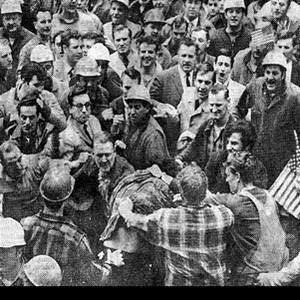
On May 4, 1970, thirteen students were shot, four of them fatally, at Kent State University in Ohio during a protest of US involvement in the Vietnam War and U.S. incursions into Cambodia. As a show of sympathy for the dead students, then-Republican Mayor of New York City John Lindsay ordered all flags at New York City Hall to be flown at half-staff the same day.
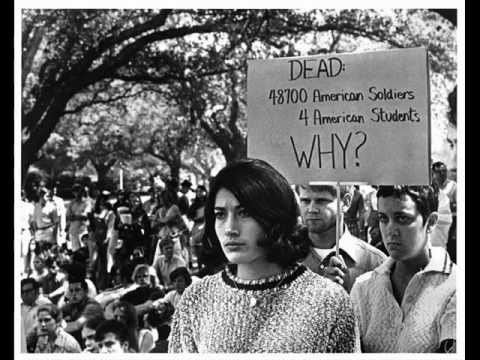
The U.S. labor movement was deeply divided over support for President Richard Nixon's Vietnam War policy. AFL-CIO President George Meany and most labor leaders in the United States were vehemently anti-communist and strongly supported US military involvement in Southeast Asia. But by 1970, union members were divided in their support for the war.
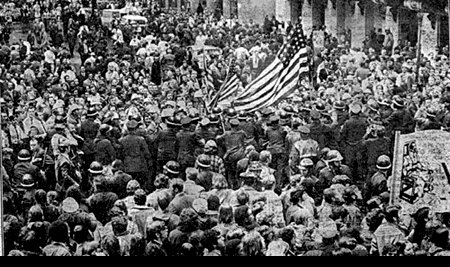
One of the strongest supporters of the president's war policy was Peter J. Brennan, president of the Building and Construction Trades Council of Greater New York, an alliance of building and construction unions in the New York City area. He was also president of the Building and Construction Trades Council of New York, the statewide umbrella group for construction unions. Additionally, he served as the vice president of the New York City Central Labor Council and the New York State AFL-CIO, umbrella groups for all labor unions in these respective areas. Brennan was a registered Democrat who had lobbied strongly for Democrats through the 1950s and 1960s, but increasingly supported Republican candidates as support for skilled labor unions decreased. The building and construction unions were overwhelmingly white, Catholic, blue-collar and male; large majorities of these supported Nixon's Vietnam policy.
Shortly after the Kent State shootings, anti-war protesters announced they would hold a rally near City Hall to commemorate the four dead students. Brennan decided to organize a counter-rally of construction workers to show support for the Nixon administration.
The riot
At 7:30 am on May 8, several hundred anti-war protesters (most of them high school and college students) began holding a memorial at Broad and Wall Streets for the four dead students at Kent State. By late morning, the protesters—now numbering more than a thousand—had moved to the steps of Federal Hall National Memorial, gathering in front of the statue of George Washington which tops the steps. The protesters demanded an end to the war in Vietnam and Cambodia, the release of political prisoners in the United States, and an end to military-related research on all university campuses.
At five minutes to noon, about 200 construction workers converged on the student rally at Federal Hall from four directions. Nearly all the construction workers carried American flags and signs that read "All the way, USA" and "America, Love it or Leave it". Their numbers may have been doubled by others who had joined them as they marched toward Federal Hall. A thin and inadequate line of police, who were largely sympathetic to the hardhats' position, formed to separate the construction workers from the anti-war protesters. At first, the construction workers only pushed but did not break through the police line. After two minutes, however, the hardhats broke through the police line and began chasing students through the streets. The workers chose those with the longest hair and beat them with their hard hats and other weapons, including clubs and steel-toe boots. Onlookers reported that the police stood by and did nothing.
Some of the construction workers and counter-protesters moved across City Hall Park toward City Hall. They mounted the steps, planted their flags at the top of the steps, then attempted to gain entrance. Police on duty at City Hall initially barred them, but soon the mob pushed past. A few workers entered the building. A postal worker rushed onto the roof of City Hall and raised the American flag there to full mast. When city workers lowered the flag back down to half-mast, a large number of construction workers stormed past the police. Deputy Mayor Richard Aurelio, fearing the building would be overrun by the mob, ordered city workers to raise the flag back to full mast.
Rioting construction workers also attacked buildings near City Hall; most were of Irish Catholic extraction and some ripped the Red Cross and Episcopal Church flags down from a flagpole at nearby Trinity Church. One group invaded two nearby Pace University buildings, smashing lobby windows with clubs and crowbars and beating up students. More than 70 people were injured, including four policemen. Most of the injured required hospital treatment. Six people were arrested.
Aftermath
During a press conference that evening, President Nixon tried to defuse the situation before tens of thousands of students arrived in Washington, D.C. for a scheduled protest rally the next day. Nixon told these protesters that he agreed with what they were trying to accomplish, and defended the recent U.S. troop movements into Cambodia as aiding their goal of peace.
Mayor Lindsay severely criticized the police for their lack of action.
Police Department leaders later accused Lindsay of "undermining the confidence of the public in its Police Department" by his statements, and blamed the inaction on inadequate preparations and "inconsistent directives" in the past from the Mayor's office.
On May 11, Brennan and officials of other unions claimed the confrontation had been a spontaneous reaction by union workers allegedly "fed up" with violence and flag desecration by antiwar demonstrators, and denied that anything except fists had been used against the demonstrators. Brennan claimed telephone calls and letters to the unions were 20 to 1 in favor of the workers. One man, Edward Shufro, of the brokerage firm Rose and Ehrman, saw two men wearing grey suits directing the workers.
Several thousand construction workers, longshoremen and white-collar workers protested against the mayor on May 11, holding signs reading "impeach the Red Mayor" and chanting "Lindsay is a bum". They held another rally May 16, carrying signs calling the mayor a "rat", "Commy rat" and "traitor". Mayor Lindsay described the mood of the city as "taut".
The rallies culminated in a large rally on May 20 in which an estimated 150,000 pro-war protesters marched without opposition through the streets of downtown Manhattan. Some workers in surrounding buildings showed their support by showering the marchers with ticker tape.
On May 26, Brennan led a delegation of 22 union leaders to meet with President Nixon at the White House and presented him with a hard hat. Nixon general counsel Charles Colson, in charge of developing a strategy to win union support for Nixon in the 1972 presidential election, identified Brennan as a friendly labor leader due to his role in organizing the counter-protests of May 8, 16, and 20. Brennan later met privately with Nixon on Labor Day.
Brennan later organized significant labor union political support for Nixon in the 1972 election. Nixon appointed Brennan as his Labor Secretary after the election as a reward for his support. Brennan was retained as U.S. Secretary of Labor by President Gerald Ford into 1975 following Nixon's resignation.
